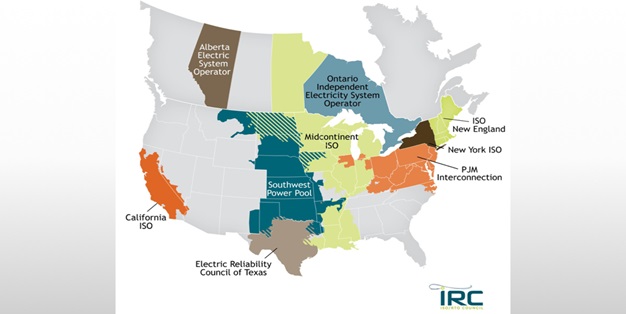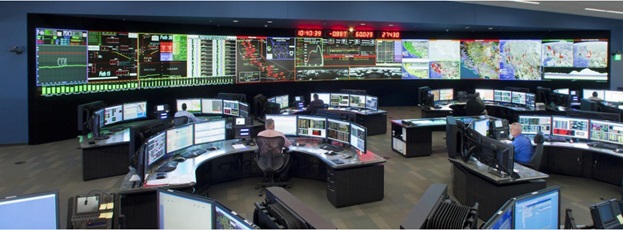MASON WILLRICH
OCTOBER 3, 2019
I. INTRODUCTION
In this essay, Mason Willrich suggests that there are important lessons for NC3 operators in how electric power utilities control their grids, and especially, how they ensure that interconnections with adjacent grids are maintained continuously in spite of the potentially catastrophic risks of grid failure arising from instability originating outside a utility system.
Mason Willrich is an energy consultant and author, Modernizing America’s Electricity Infrastructure, 2017. He has led electric utilities and served as legal advisor to US negotiators of nuclear arms control agreements. He was SAC bomber pilot from 1955-57.
Acknowledgments: The workshop was funded by the John D. and Catherine T. MacArthur Foundation.
This report is published simultaneously here by Nautilus Institute and here by Technology for Global Security and is published under a 4.0 International Creative Commons License the terms of which are found here.
The views expressed in this report do not necessarily reflect the official policy or position of the Nautilus Institute. Readers should note that Nautilus seeks a diversity of views and opinions on significant topics in order to identify common ground.
Banner image is by Lauren Hostetter of Heyhoss Design
II. NAPSNET SPECIAL REPORT BY MASON WILLRICH
INNOVATION AND ADAPTIVE CONTROL IN AMERICA’S ELECTRIC INFRASTRUCTURE: PARALLELS TO NC3
OCTOBER 3, 2019
Summary
Electricity infrastructure is composed of electric generation, transmission, distribution, and retail supply for use in consumer applications. Each of these major components is interconnected and interactive with the others. The Command function for initiating the use of United States nuclear armed forces will be a command from the United States President and Commander-in-Chief, to the Commander, United States Strategic Command. Such a command from the president will signify the failure of nuclear deterrence and the result will be devastating destruction within an adversary nation. The Command function within America’s electricity system is the aggregate of individual commands issued by millions of American consumers of electricity. The result will be delivery throughout America’s economy and society of an essential, beneficial service. These two Command functions are located in worlds that are very far apart. However, the Control and Communication functions within America’s electric system should be mined for insights regarding NC3. This is especially the case for the control and communication functions of the seven regional RTO/ISO organized wholesale power markets which deliver electricity —continuously — to most of America’s electric consumers. Finally, both NC3 systems and electric systems share a common threat — the risks posed by cyber attacks.
Introduction
Electricity infrastructure is composed of electric generation, transmission, distribution, and retail supply for use in consumer applications. Each of these major components is interconnected and interactive with the others. America’s electricity infrastructure spans the entire nation and provides essential electric services to almost the entire population at home, at work, and often at play.
Modernizing America’s electricity infrastructure is a vital project in our national interest. Climate change — specifically global warming — poses a global threat to the welfare of future generations of human beings. For America to maintain a structure of economic growth that will be environmentally sustainable for the long term, America’s energy infrastructure as a whole must be transformed from primary reliance on fossil energy resources — coal, oil, and natural gas — to primary reliance on carbon-free energy resources — mainly nuclear, hydro, wind, solar resources, and overall improvements in the efficiency of energy use.
Transportation and electric power generation are the two largest emitters of the pollutants that cause global climate warming. Consequently, America’s electricity infrastructure will be both the leading edge and the central front in our transition away from fossil to carbon-free resources.
Our challenge is to increase significantly the current rate of innovation within our electric infrastructures while maintaining affordability, reliability, and security of electric services for electricity consumers.
This paper draws from my book, Modernizing America’s Electricity Infrastructure.[1] I will summarize the ownership and operation of America’s electricity infrastructure, focusing on the control and communications functions. I will end with insights that may be useful for those who are responsible for America’s nuclear forces command, control, and communications systems.
Ownership
Electricity Providers
Investor-owned utilities (IOUs), mostly consolidated into 47 large multi-state holding companies serve 70% of America’s 150 million electricity customers. Publicly owned utilities (POUs) — municipal, state, cooperative, and federal — serve the remaining 30%.
Transmission
IOUs own 66% of high-voltage transmission lines. POUs own 29%, while independent transmission owners (Transcos) own 4%.
Generation: Ownership and Energy Resource Mix
Regarding electric generation, independent, non-utility power producers (IPPs) own 43%, and IOUs own 36%, while POUs account for 21%.
The largest fuel source for this capacity is natural gas (43%), followed by coal (23%).
Carbon-free nuclear, hydro, wind, solar, biomass, and geothermal accounts for the remaining 33%. In 2007, coal accounted for 50% of generation capacity. Since then, coal has declined, less polluting and cheaper natural gas has expanded, and cheaper wind and solar have recently accounted for the largest share of new generation capacity added.
Despite President Trump’s executive order to keep coal-fired generators running, the largest annual increment of coal generation plant retirements occurred in 2018. On the other hand, proposals to order a new utility-scale generation — including a coal-fired generator — will in general require approval by the relevant state PUC.
Distributed Energy Resources
Increasing amounts of electricity are being generated on the premises of electricity consumers — residential, commercial, and industrial. These consist largely of solar installations on rooftops and combined heat and power plants in basements. Small generators are also beginning to populate the distribution networks of electric utilities, and energy storage projects are being deployed both behind and in front of utility customers’ meters. Together, these generating sources, along with energy efficiency, are commonly classified as distributed energy resources (DERs). Modernization of electric distribution infrastructure will involve the incorporation of smart-grid technologies and applications as follows: a variety of sensors for monitoring the functioning of equipment, appliances, and operations; hardware and software for digital data acquisition, analysis, storage, and use to automate and control of a wide variety of operations; and telecommunications that link everything to everything required to operate a largely automated, state-of-the-art electric distribution system.
Electric System Operations
Interconnections
America is divided electrically into three huge interconnections — Eastern (750,000 MW of generating capacity), Western (125,000 MW), and Texas-ERCOT (95,000 MW) — 95,000 MW (see Figure 1).
Alternating current (AC) power flows from generators at high voltages to substations operated by local distribution companies where the voltage is reduced and distributed through their networks to consumers. Each regional interconnection operates independently of the others.

Figure 1: North American grid interconnections
Operating Responsibility
Operating responsibility for America’s electric transmission networks is dispersed among widely divergent business models that co-exist under the transmission open-access regime established by the Federal Energy Regulatory Commission (FERC) in 1996.
Overall, the grids are operated within a framework of 66 balancing authorities, each of which provides centralized control within its distinct geographic footprint. Within their footprints, balancing authorities maintain a precise balance between generation resources and electric consumer loads, as loads vary throughout 60 minutes/24 hours/365days/year (see Figure 2).

Figure 2: NERC balancing authorities
Seven of the 66 balancing authorities are FERC authorized and regulated non-profit Regional Transmission Organizations or Independent System Operators (RTO/ISOs), which operate, but do not own transmission. RTO/ISO territories are defined by membership, and their footprints cover New England, New York, the Mid-Atlantic, Midwest, Southwest, and most of California. RTO/ISOs provide transmission service for about two-thirds of America’s electricity consumers. The most important function of the RTO/ISOs is operating competitive wholesale markets for load serving entities within their footprints, and generators within their footprints, and also occasional imports from outside.

Figure 3: Organized wholesale power markets — RTO/ISOs
Starting with a forecast of electric loads, including load shape for the 24 hour period, and a list of pre-qualified generators wishing to participate, the RTO/ISO accepts bids from generators wishing to participate in the day ahead market until the generator bids total enough to supply the total of electric loads forecasted. The price bid by the last generator sets the price for all the other generators participating — the market is a so-called Dutch auction. The day-ahead market is followed by hour-ahead and real-time markets. In order to follow closely the particular load shape throughout the day, the control room staff will dispatch generators that play a variety of roles, including base load, ancillary services — regulation up, regulation down (over the peak load), spinning reserves, and even residual unit commitment (which are generators paid to stand by in case of a wide variety of contingencies occur. It is important to underline that these RTO/ISO control and communications functions cover multi-state regions and reach millions of end points. RTO/ISOs are high performance organizations performing continuous control and communication functions.

Figure 4: Control room — California ISO
Outside the footprints of seven RTO/ISOs and the competitive wholesale markets they manage, the remaining one-third of electricity consumers are served by IOUs or POUs that are more fully integrated generation, transmission, distribution, or transmission, distribution utilities. These utilities manage their own balancing authorities. This is the situation in America’s northwest and southwest regions.
Electric Industry Policy: Selected Aspects
Electric System Planning
Long-term planning is an essential activity in every capital-intensive industry. Within the electric utility industry, the planning horizon is up to twenty years, with serious attention focused on the first five years. The key planning parameter is a forecast of aggregate demand from all classes of electric consumers, which is used to determine the need for additional generation units. Traditionally, the main criterion used to determine need is the “one day in ten years” loss-of-load probability (LOLP). In other words, additional generation is based on meeting consumer demand, while limiting losses of electric service to no more than one day in ten years. The “one day in ten years” LOLP has been criticized as overly conservative, resulting in excess investment in generation capacity.
In the 1980s, state legislatures and/or PUCs modified traditional utility practice by requiring their planning to include savings from energy efficiency programs along with supply-side energy resources — so-called integrated resource planning (IRP). Soon, IRP became favored as a means to increase fuel diversity and to reduce environmental impacts. FERC also adopted this modification at the federal level for transmission planning. RTO/ISOs are required to include alternatives to transmission for evaluation alongside transmission-expansion alternatives proposed by participating transmission owners.
IRP is a rational process for stakeholders and regulatory commissions to participate in decision-making about electric infrastructure development. Thirty-nine states require their electric utilities to develop and publish IRP plans.
Electric System Reliability and Cybersecurity Standards
In America, and elsewhere in post-industrial and industrially advanced economies and societies, the importance of continuous electricity service is increasing. The Internet, smart phones, entertainment media, robotics, and Wi-Fi networks are energized by electricity. Mandatory reliability standards for America’s bulk-power system, including generation and transmission, have been in effect nationwide since Congress enacted the Energy Policy Act (EPAct) in 2005, after a blackout cascaded throughout the northeastern United States and Canada in 2003.
Mandatory reliability standards for the bulk-power system have not only increased the reliability of America’s bulk-power system, but also enhanced the operational performance of wholesale power markets. Maintaining and improving overall electric system reliability will be a particular challenge, however, where large amounts of variable wind and solar resources are incorporated into America’s electricity infrastructure. Congress should amend EPAct 2005 to extend mandatory reliability and cybersecurity standards for distribution networks.
Interoperability and Cybersecurity Standards
The Energy Independence and Security Act of 2007 (EISA 2007) calls for the US Department of Commerce’s National Institute of Standards and Technology (NIST), in cooperation with DOE, to lead development of interoperability and cybersecurity standards for smart-grid components. In October 2014, NIST’s work, in collaboration with industry stakeholders, culminated in NIST Framework and Roadmap for Smart Grid Interoperability Standards. The framework contains seventy-four standards and protocols. However, compliance with the NIST standards is voluntary, not mandatory, for industry participants. It remains to be seen whether federal interoperability standards — that are broad enough to achieve workable interoperability throughout the vast networks involved in America’s electricity infrastructure as it evolves — will be adopted by a consensus within the industry.
Environmentally Sustainable
The twenty-first meeting of the Conference of the Parties to the United Nations Framework Convention on Climate Change (UNFCCC) was held in Paris in December 2015 (COP21). At COP21, 196 countries, including the United States, agreed to: “Hold the increase in the global average temperature to well below 2 degrees C above pre-industrial levels and to pursue efforts to limit the temperature increase to 1.5 degrees C above pre-industrial levels, recognizing that this would significantly reduce the risks and impacts of climate change.” The agreement rapidly received sufficient ratifications to enter into force on November 4, 2016.
It is noteworthy that any party may withdraw from the Agreement, but only after three years from the date when the agreement entered into force for that party November 4 for the United States, and the party’s withdrawal becomes effective one year after notice of withdrawal is received.
President Trump’s withdrawal from the UNFCCC will not become effective until November 4, the day after America’s 2020 presidential election on November 3. In the meantime, a large coalition of state, city, business, financial, academic, environmental, tribal, faith, cultural, healthcare leaders across 50 states have signed the We are Still In Declaration, demonstrating America’s enduring support for the Paris Agreement, and climate action.
Congress should appoint a national commission to evaluate America’s electricity infrastructure in operation and under construction in order to recommend a national plan to reduce CO2 emissions from the power sector by 80% below 1990 levels by 2050. The plan should also limit methane leakage from natural gas infrastructure to an amount consistent with attainment of a national, established goal of limiting global warming to two degrees Centigrade in 2050. The commission should also evaluate proposals for a carbon tax that would work in harmony with other energy and environmental policies. The work of the Congressional commission proposed above should provide the path forward for decarbonizing America’s electricity infrastructure.
US Nuclear Command, Control and Communication (NC3)
Insights from America’s Electricity Infrastructure
The Command function for initiating the use of United States nuclear armed forces will be a command from the United States President and Commander-in-Chief, to the Commander, United States Strategic Command. Such a command from the president will signify the failure of nuclear deterrence and the result will be devastating destruction within an adversary nation.
The Command function within America’s electricity system is the aggregate of individual commands issued by millions of American consumers of electricity. The result will be delivery throughout America’s economy and society of an essential, beneficial service.
These two Command functions are located in worlds that are very far apart.
However, the Control and Communication functions within America’s electric system should be mined for insights regarding NC3. This is especially the case for the control and communication functions of the seven regional RTO/ISO organized wholesale power markets which deliver electricity — continuously — to most of America’s electric consumers.
Finally, both NC3 systems and electric systems share a common threat — the risks posed by cyber attacks. It could well be helpful for those responsible for NC3 cyber risk management to share information and experience with the President’s National Infrastructure Advisory Council, which issued Addressing Urgent Cyber Threats to Critical Infrastructure in August 2017, and Surviving a Catastrophic Power Outage in December 2018.
III. ENDNOTES
[1] M. Willrich, Modernizing America’s Electricity Infrastructure, MIT Press, October 2017, at: https://mitpress.mit.edu/books/modernizing-americas-electricity-infrastructure.
IV. NAUTILUS INVITES YOUR RESPONSE
The Nautilus Asia Peace and Security Network invites your responses to this report. Please send responses to: nautilus@nautilus.org. Responses will be considered for redistribution to the network only if they include the author’s name, affiliation, and explicit consent


